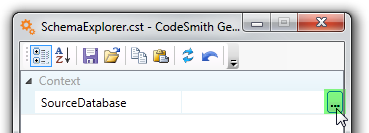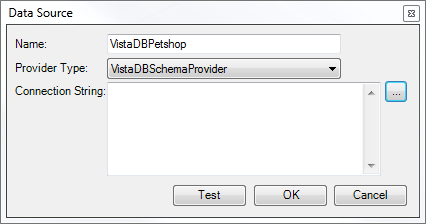Using SchemaExplorer
SchemaExplorer is CodeSmith Generator's built-in interface for working with metadata from databases. You can use the classes in SchemaExplorer either programmatically or interactively; often, you'll combine the two approaches. For example, you may want to allow the user to interactively select a database, and then programmatically build a list of all of the tables in the selected database. Here's a template that demonstrates using SchemaExplorer for this purpose:
<%@ CodeTemplate Language="C#" TargetLanguage="Text" Description="List all database tables" %>
<%@ Property Name="SourceDatabase" Type="SchemaExplorer.DatabaseSchema" Category="Context" Description="Database containing the tables." %>
<%@ Assembly Name="SchemaExplorer" %>
<%@ Import Namespace="SchemaExplorer" %>
Tables in database "<%= SourceDatabase %>":
<% for (int i = 0; i < SourceDatabase.Tables.Count; i++) { %>
<%= SourceDatabase.Tables[i].Name %>
<% } %>
Before you can execute this template, you must supply a value for the SourceDatabase property. When you place your cursor in the property sheet row for this property, CodeSmith Generator will display a builder button (highlighted in green), indicating that there is an external editor hooked up for this property. CodeSmith Generator automatically uses editors built into SchemaExplorer:
Clicking the builder button opens the Database Picker dialog box. A dropdown list lets you choose from all of the data sources that you have previously defined on your computer. There's also a builder button to define a new data source:
If you click the builder button, SchemaExplorer opens the Data Source Manager dialog box. Here you can see the type of each existing data source, and manage your data sources. You can copy, add, edit, or remove data sources from this dialog box.
If you choose to add a new data source, SchemaExplorer opens the Data Source dialog box. To add a new data source, you must provide a name for the new data source, then select a provider type and type in a connection string.
It's worth noting that CodeSmith Generator ships with many database providers including the following:
- ADOXSchemaProvider
- ISeriesSchemaProvider
- MySQLSchemaProvider
- OracleSchemaProvider
- PostgreSQLSchemaProvider
- SQLAnywhereSchemaProvider
- SqlCompactSchemaProvider
- SQLiteSchemaProvider
- SqlSchemaProvider
- VistaDBSchemaProvider
Here's a sample of the output for this template when it's used with the SQL Server Northwind sample database:
Tables in database "Northwind":
Orders
ComponentTypes
Products
Order Details
CustomerCustomerDemo
CustomerDemographics
Region
Territories
EmployeeTerritories
Employees
Categories
Customers
Shippers
Suppliers
After the user specifies the SourceDatabase, CodeSmith Generator is able to use it as the root of an object model of the entire database.
Check out this video for more information:
Refer to the CodeSmith Generator API Reference for a complete listing of the classes and members within the SchemaExplorer library.
Advanced: Using Extended Properties to Define Custom Metadata



